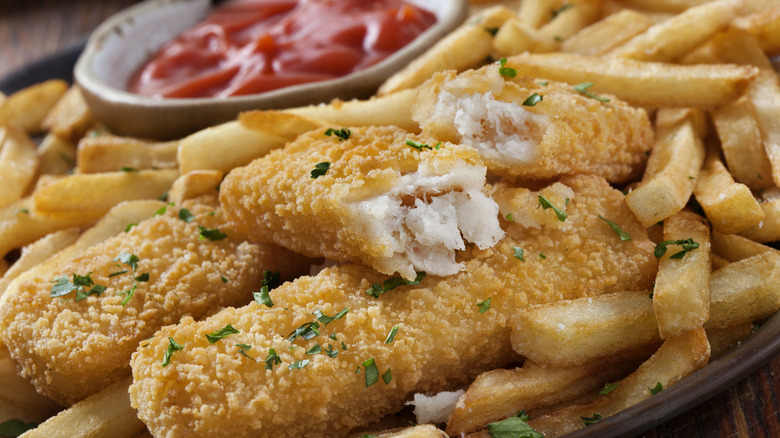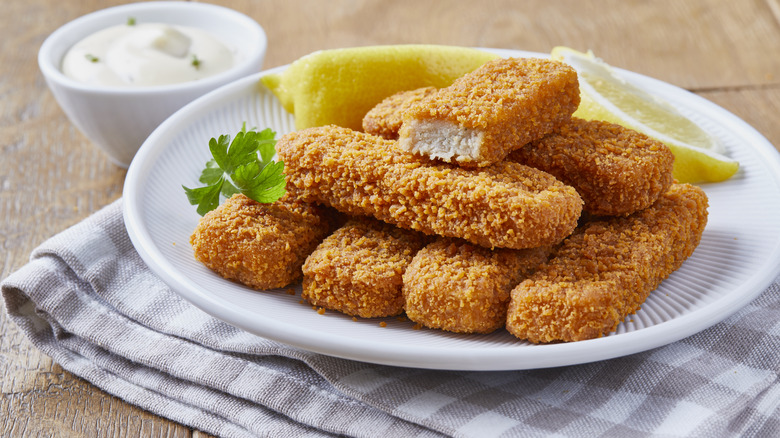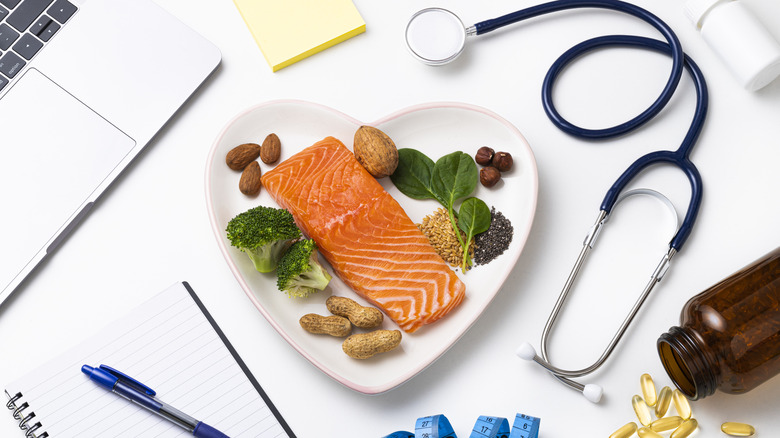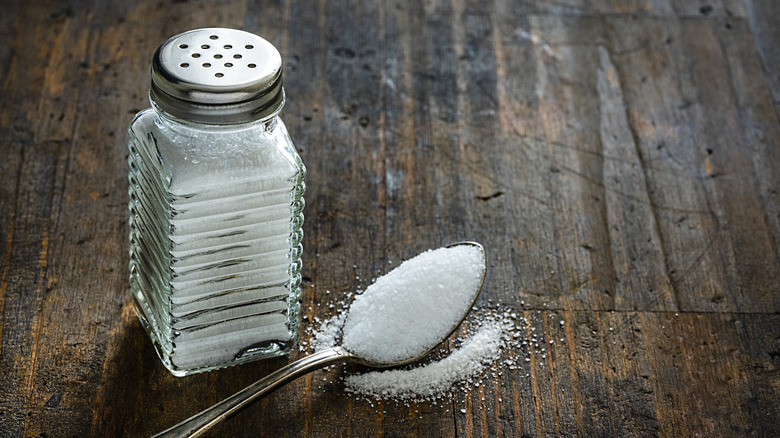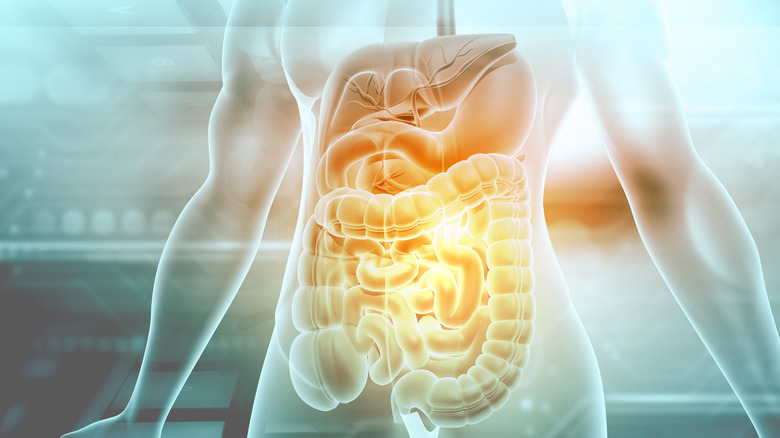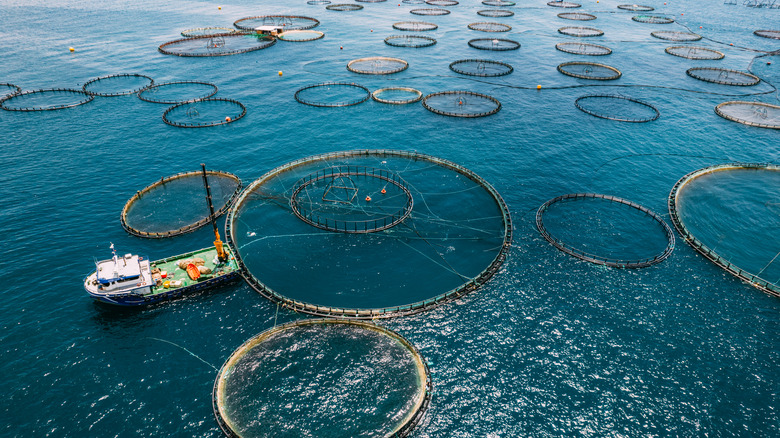Why You Should Think Twice Before Eating Fish Sticks
Like many foods that have gained popularity over the years, fish sticks became more common when war and scarcity edged out other proteins as dinnertime possibilities. With food rationing being what it was during and after the war years in the 1940s and 1950s, American consumers and food producers looked for something — anything — to replace beef, chicken, and pork on roast night. During that era, fish was a generally disliked commodity due to its tendency to rot in transport. People ate only about seven pounds of it each year, which basically amounts to six bags of frozen fish sticks at the supermarket today.
After much trial and error, the first fish sticks hit grocery stores in 1953. Seafood producers had finally perfected the breaded finger-sized bites, affectionately called "the ocean's hot dogs" by historian Paul Josephson decades later. For busy post-wartime housewives, they meant a quick dinner that required only a few minutes of cooking time, just like hot dogs. With the help of a little — okay, a lot — of advertising, frozen fish sticks caught on, with Gorton's brand reigning supreme in the early fish sticks wars.
Today, people eat about 55 million pounds of fish sticks each year. However, many of the troubles that plagued early fish sticks are still troubling this popular cafeteria staple. Today, there are a few more challenges that the original makers probably didn't intend, causing some to think twice before indulging in a plate of these breaded bits of fish.
Some brands use farm-raised fish
The trouble with the glitzy retouched photos on the front of fish sticks boxes is that you don't really know if those fish come from a farm or from the open sea. To combat this, some fish stick makers have adopted a labeling system, which indicates, for example, whether a farm-raised fish is handled responsibly or whether an ocean-caught fish meets sustainability standards. These labels help consumers understand the environment the fish lived in before being processed. However, the system is far from perfect. And not all fish manufacturers have come on board with labeling
For average consumers, this comes with real consequences. Farmed fish sometimes live on a diet of subpar foods, like soy and corn, and an infusion of antibiotics that producers rely on to keep diseases at bay. While antibiotic use in fish farms is a last-resort measure, the practice isn't uncommon. In the wild, predators find and eat sick and diseased fish, taking the danger of disease out of the environment. In the fish farm's closed environment, larger predators aren't always around to clean the population, which means the fish growing there may get enough antibiotics to knock an ear infection out of an elephant. If you decide to eat some fish sticks and tartar sauce, be sure read the labels on all of the brands to find the ones from companies that don't use farm-raised fish.
Farm-raised fish may not be as nutritious
In the wild, fish spend their days swimming around, hunting for food. As such, wild fish enjoy robust diets filled with nutrients that make them strong and allow them to develop stores of omega-3 fatty acids in their system. Some farm-raised fish subsist on a diet that is the equivalent of rabbit food, which doesn't provide the necessary nutrients required for building up omega-3s in their systems. In turn, consumers of fish sticks don't get the required omega-3s their body needs to perform critical functions, like hormone creation for blood clotting or anti-inflammatory benefits. This essential fatty acid also plays an important role in cardiovascular health and may help curb conditions such as eczema and lupus.
All of this means if you're eating fish sticks because you've heard that fish supplies a good amount of healthy omega-3 oils, your efforts may be in vain, despite your good intentions. You can't always tell a fish stick's nutritional quality just by looking. An article in the journal Foods offers consumers some guidelines for buying fish to ensure that it meets nutritional and safety standards, including the suggestion to buy from reputable vendors and companies. You can also read reviews, but it's best to walk away from fish sticks brands if their origins and therefore, their nutritional contents, are dubious. Or you can seek out fish that have been caught in the wild, and make your own fish sticks from scratch.
Fried foods can cause heart health issues
For many people, a platter of fish sticks, a side of fries, and an abundance of tartar sauce equal comfort on a plate, a meal that our moms made for us on a rainy day for lunch. Part of the appeal, aside from the walk down memory lane, is that fat in foods makes the smell more concentrated -– read more delicious here. But a darker side to this comfort food equation exists.
Greasy fried foods like fish sticks and french fries increase the likelihood of conditions like cardiovascular disease. A study in the journal Circulation: Heart Failure indicated women who ate up to three servings of fried fish per week increased their risk of heart failure by almost 50%. Another study found that fried fish eaters who indulged at least twice a week saw a 63% increased chance of experiencing a stroke or heart attack.
On a related note, the trans fats in fried fish sticks contribute to weight gain and obesity, two factors that can increase heart attack risk. It's fair to say that trans fats are tricky. There is some evidence to suggest that you may gain weight from eating trans fats even if your calorie intake remains the same. In other words, if you've ever joked about gaining weight just from smelling fish sticks, the actual effect, and the resulting poor health, is closer to reality than you could have imagined.
Fish sticks have a high fat content
While brands may vary, fish sticks generally have about 9 grams of fat per serving (about 2 grams of which are saturated fats), with more than half of the calories you get coming from that fat. Before you chow down on some crispy fish wonders, consider this. It is recommended that a person's daily caloric intake consist of 10% saturated fats or less, a figure based on a 2,000-calorie-a-day diet. Granted, you don't get as much trans fat from eating fish sticks as you would, say, from opening up a tub of butter and eating straight out of the carton, but not by much in all reality.
And higher fat diets, especially those that embrace trans and saturated fats, can increase your risk of mortality by 8% for every 5% increase in calories from bad fats in your diet (via Harvard T.H. Chan School of Public Health). But that's not all. The same study also suggests that trans fats jack up the likelihood that you'll experience respiratory or neurodegenerative diseases if you consistently eat a diet filled with those harmful fats. Not all fats are bad, of course. Mono- and polyunsaturated fats from flax seeds and walnuts, as well as from non-fried fish, help reverse neurodegenerative and respiratory disease risk.
So the lesson here isn't to avoid eating fish. It's don't eat fried fish, including fish sticks.
Commercial fish sticks can be high in sodium
The use of sodium stretches back thousands of years. In the days before refrigerators were ever even conceived, people cured meats in salt to preserve them. The human body requires a little of this seasoning to ensure the proper functioning of muscles and nerves. It also happens to just taste good, which is why so many people generously salt their meals.
Unfortunately, some dishes, like fish sticks, can get a big dose of salt during the preparation process. Commercial fish sticks companies add anywhere from 240 milligrams to 430 milligrams per serving to their fish sticks. According to the Food and Drug Administration (FDA), low-sodium foods have 140 milligrams or less per serving, which means many seafood companies add almost double or triple that amount in their products. More unfortunate than that is the fact that salt has been shown to contribute to high blood pressure. Non-Western countries, where a low-sodium diet is embraced, don't have issues with hypertension as they advance in years. In other words, high blood pressure isn't necessarily an age-related thing. It's often more of a diet-related one.
They make for a highly processed meal
The words "highly processed" get tossed around so much these days that they've kind of lost their meaning, which suggests people may have forgotten that they can do their body a serious amount of harm over time. So, let's begin the fish-sticks-as-a-processed-food conversation by reminding people what it means for a food to be processed. According to an article in the Public Health Nutrition journal, highly processed foods are almost entirely "derived from foods and additives." They are far removed from a food's natural state. In other words, they're non-foods.
These chemistry experiments often have a list of ingredients that even the most-studied scientist would have difficulty understanding. Many of these chemicals are meant to extend an item's shelf life in stores. These foods also typically have lots of sugar, salt, and unpronounceable ingredients that can contribute to conditions like diabetes, heart disease, and dementia over the long haul.
As it turns out, those substances -– and make no mistake, they are substances -– also unleash a river of dopamine in your brain to the same degree that booze and cigarettes do. That means processed foods like fish sticks can trigger addiction. "Many people report eating highly processed foods not only for the calories they provide, but also to experience pleasure and cope with negative emotions," according to a National Poll on Healthy Aging. "Cravings for highly processed foods can also be intense and challenging to resist."
You may have trouble digesting them
If you were ever inclined to start a business that has any hope of being successful, might we suggest that you start a digestive aids business? By the year 2025, the global antacids market is projected to grow to nearly $4 billion and enjoy a compound annual growth rate of 4.5%. That's a lot of Alka Seltzer. Of course, since we're being honest, we must also point out that lifestyle, including diet, contributes greatly to whether or not you need a little plop, plop, fizz, fizz at the end of each day. You can probably guess that fish sticks count among those foods that cause digestive distress.
Greasy, fried foods squash out the good bacteria in your tummy, making digestion more difficult. Many foods like fish sticks also come with little fiber, which causes your digestive tract to have to work overtime. Fatty molecules run large on the chemical level. This means that your system needs more turns of the hourglass to complete digestion. Ironically, despite staying in the digestive system longer than low-fat foods, fried foods contribute to overeating because you don't feel as satisfied as quickly as you would with low-fat, high-fiber foods like apples and oatmeal. It's safe to say that fish sticks plus french fries equal an uncomfortable clog in the system and a great deal of stomach pain after dinner.
They could hamper your dieting efforts
If you're like most people, you'll go on at least two diets this year, per a poll from Love Fresh Berries as reported in The Independent. And you'll eventually embark on about 126 fad diets over the course of your lifetime. It's also likely that the temptation from comfort-food favorites like fish sticks will cause you to abandon your diet after six days because ingredients like salt, fat, and sugar –- which fish sticks have in abundance -– cause the kind of diet-breaking cravings we all hate.
Aside from this, fish sticks come loaded with calories, with some brands having 260 calories or more per serving. Compare that to a baked potato, which has about 100 calories and about 16% of your daily fiber requirements, and you'll see why something as small as a fish stick can ruin a weight-loss plan.
But it isn't just the calories in fish sticks that pack on the pounds. Fish sticks (or any fried food, really) cause inflammation in the body. Inflammation can contribute to weight gain and trouble losing weight. It has also been associated with insulin resistance, another factor that packs on the pounds and creates a layer of fat on the liver. If you guessed that these factors -– excess weight, insulin resistance, and inflammation –- create a seemingly never-ending vicious loop that keeps the weight on, you'd be right. And fried foods like fish sticks play a big part in this.
Breaded, fried food like fish sticks can cause inflammation
Unfortunately, one of the biggest contributors to the prevalence of bodily inflammation is the food we eat. And yes, that includes those greasy, fried comfort foods we grew up with like chicken nuggets, french fries, and fish sticks. Advanced glycation end products are a big byproduct of fried foods and known to be one of the sources of inflammation in the body. (Injuries are the other cause of inflammation, called "acute inflammation.") Novant Health points out that nearly half of all the deaths in the world come from diseases known to arise from chronic inflammation, like diabetes, cancer, and stroke.
Chronic inflammation challenges the body in ways that injuries and acute inflammation don't. That is, the effects start out as a whisper, and only with time do the effects of inflammation get bad enough to make you notice. Consider rheumatoid arthritis in its early form, and you'll begin to understand how inflammation sneaks up on you slowly. For example, rheumatoid arthritis may start out as just a bit of stiffness when you wake up in the morning, but the stiffness disappears once you get to start moving. It's only when the disease progresses and movement doesn't offer the relief it once did that you see inflammation's full effects. The good news is if fish sticks and other fried foods cause inflammation, there are also foods like fresh berries and beans that help heal inflammation in the body.
Fish farms may be bad for the environment
It is estimated that 70% of the world's wild fish population has fallen prey to overfishing and exploitation, per Encyclopedia Britannica. Fish farming, or aquaculture, helps to mitigate some of the issues caused by overfishing. For example, these farms give wild fish populations a breather, allowing them to go forth and multiply once again. Fish farms also supply seafood manufacturers, including those that sell fish sticks, with the necessary stocks to keep their businesses running. However, it's probably also accurate to say that fish farms, particularly those that are housed in ocean waters, may do as much harm as they do good. In a day and age when more people want to eat food that comes from sustainable sources, fish sticks made from farm-raised fish may get tossed back into the proverbial waters by some environmentally minded consumers.
Farmed fish that live in ocean-based holding areas have a greater susceptibility to disease and parasites due to the close proximity in which they're raised. Some farm fish also escape their ocean-based containments and end up swimming free with the masses. One problem with this is that some of those fish are the aquaculture equivalent of Typhoid Mary, and any disease that infected their pens eventually spreads to the wild fish population. It's also the case that some of the treatments that fish farms use on sick and diseased fish leech into nearby waters, shorelines, and farmland, causing contamination.
They can go bad if not stored properly
Frozen fish sticks remain a go-to meal for people whose days contain too many things to do in the too few hours they have available. Many fish sticks brands come microwave-ready, while others require just about 15 minutes in the oven. They're ready to go from freezer to table in a matter of minutes until they aren't. Like all frozen foods, fish sticks can succumb to bad freezer conditions. However, unless they smell strongly like standing, rotting water –- read really, really fishy smell -– it's not always easy to tell if they've gone bad.
In general, fish that is starting to turn to the dark side will feel and look different (aside from just smelling sour-ish or like ammonia). It'll take on a suspicious gray color and become slimy to the touch. While frozen fish sticks tend to stay frozen throughout their shelf lives, it's not impossible for them to turn bad like any other fish. This can happen if your freezer goes out, for example, and the fish has gotten warm in the process. Even if your fridge kicks back on, your frozen sticks may no longer be edible. Finally, if your fish sticks come out of the freezer with a layer of ice crystals on them, it might mean that freezer burn has gotten your fish. Freezer-burned food tastes nasty, even if it's not technically dangerous to eat. Since no one likes to eat yucky-tasting food, just toss it.
